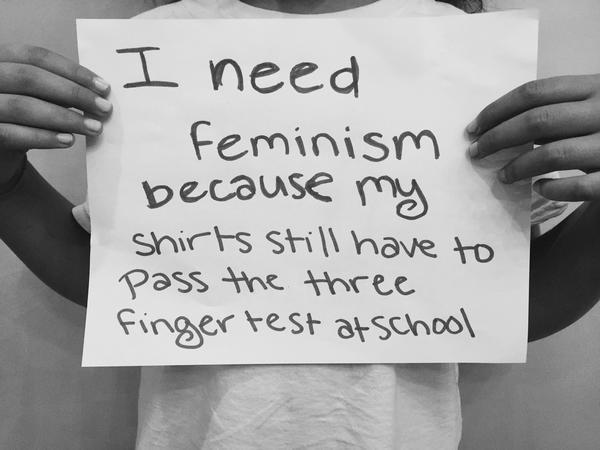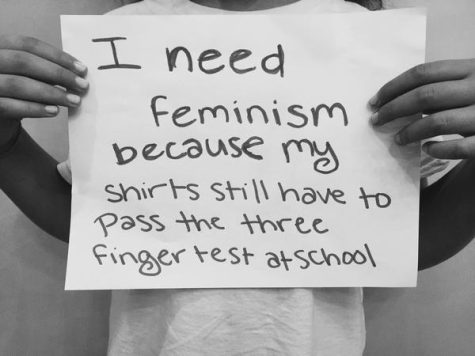Dress Code and Feminism

“Ariela Basson, an author holds a sign about feminism and school dress codes. (Provided by: Jewish Women’s Archive)”
October 24, 2022

“Why are we teaching guys that it’s okay to blame girls for their lack of self-control? Dress codes promote rape culture and sexism towards women.”
Dress code has always been a very controversial topic. Many people think that the dress code should be enforced as it promotes a serious school atmosphere, allows students to focus on their school work, promotes good behavior, and emphasizes academics. At the same time, many people think that the dress code is something that is built against women and that it promotes rape culture, stereotypes against women, sexism, and so much more.
It is no lie that the dress code is definitely more enforced on women than it is on men, which is completely wrong.
A man and a woman could be wearing a tank top, but a woman would be the one to get dress coded. This proves that the dress code is not put in place to create a better learning environment, but to make sure that men are not distracted by women’s bodies. This is ridiculous, as it is not a woman’s job to make sure that a man isn’t distracted by her body.
Not only is the dress code more enforced on women but the dress code is more enforced on thick and curvy girls. Women who are thicker or curvier are dress-coded more frequently compared to less thick and curvy women. Again, all of this goes on to prove that the dress code is put in place to ensure that men are not distracted by women’s bodies, NOT to promote a better learning environment.
The dress code is sexist, as it is basically implemented for the benefit of boys, so they aren’t “distracted.”
Aside from the dress code only being enforced more on women and women with certain body types, the dress code sends the wrong message to women about their bodies.
Throughout their whole school lives, most girls have been told to cover up their bodies because they are distracting boys. When young girls are constantly taught this, they might grow up to think that it is their job to ensure that men aren’t being distracted by their bodies. This changes the way women view their own bodies, in some sense, the dress code portrays to a girl that her body is purely a sexual object. It shows girls that if a little bit of skin is shown it will be a problem for boys, and they will not be able to focus on whatever schoolwork they have to do. All of this is being said because when girls are dress coded the only reasoning they get is that their bodies are being distracting or that their bodies and body shapes are inappropriate.
This is a problem for many reasons.
Here at Millbrook we do not have a strict dress code and can really wear whatever we want as long as it is not inappropriate, which is really good. Many students at Millbrook agree with the dress code that is implemented at our school. Sophomore Kenley Belcher says, “Millbrook does not really have a strict dress code and it should stay that way people should be able to wear what they want to wear.”
With all of this being said, girls going to school in inappropriate clothing is definitely not being promoted. But there should be a balance, girls should be able to show some skin or their shoulders without it being a problem for anyone. Quite frankly if a boy can not contain himself when he sees a girl’s shoulder, then he should seek professional help. Nadine Doudari, a Millbrook parent of a sophomore says, “It is very important that students go to school in respectable clothing, but to dress code girls for wearing a tank top and telling her that she is distracting boys? It’s crazy.”
Feminism promotes equality and the dress code is the opposite of equality as it almost only applies to women in most places.
If schools want to implement a dress code, that’s completely okay as the dress code does have many many benefits to students learning. However, the dress code should be implemented in the same way for EVERYONE. Not just girls. Not just thick girls. Not just curvy girls. All students in a school.











